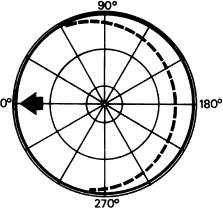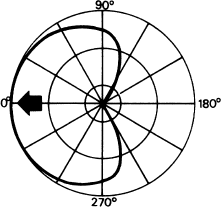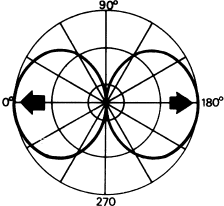Microphone Categories
The directivity pattern (or polar diagram) of a microphone indicates its response to sounds from different directions. The most important directivity patterns are given below.
Omni-directional
Sound pick-up is normally independent of angle of incidence but in fact this is only the case at the lower frequencies (typically below 2–4 kHz). Except as ‘personal’ microphones (e.g. for use with radio microphone systems) the use of omni-directional microphones is limited in television studios because of their inability to reject reverberation and general studio noise.
Cardioid
These are widely used because, when pointed at an artiste or presenter, their ‘dead’ sides are likely to be directed towards areas of noise in the studio. They also reject a significant amount of reverberation.
Figure-of-eight
These are relatively little used in television work but they may have occasional application in out-of-vision situations where the ‘dead’ sides can be used to reject unwanted sounds. A well-known type of ‘noise-cancelling’ microphone— the so-called ‘lip-ribbon’, much used for commentaries—has a figure-of-eight response, although its rejection of external sounds depends on other properties.
Hypercardioid
This is a pattern half-way between figure-of-eight and cardioid, and can often be useful when the unwanted noises are neither at the rear nor at the sides. The frontal angle of pick-up is narrower than that of a cardioid. This can be an advantage in some instances, a drawback in others.
Gun microphones
So called because of their shape, there are basically two types: ‘short’ guns with a tube about 25 cm long, and the longer variety with a tube length of around 50 cm. The short guns usually have a directivity pattern which is not unlike a hypercardioid and is sometimes described as such by the makers. The longer microphones have an angle of pick-up at high frequencies of about 30°. This broadens as the frequency decreases to being, in a typical case, approximately cardioid at low frequency. The longer gun microphones rarely perform well in small rooms.
Variable directivity
Inevitably these are relatively expensive. However, the cost may be justified because, by operation of a switch, either on the body of the microphone or on a remote box, the directivity pattern can be changed from omni-directional to cardioid, to figure-of-eight or intermediate patterns (but not gun).
Sensitivity is more-or-less equal all round.

Cardioid
Some degree of directionality is introduced to produce a heart-shaped response curve.

Figure-of-eight
Bi-directional sensitivity allows equal response in opposite directions.

Highly directional
Special constructions, such as the gun microphone, allow small sources to be pinpointed.

Hypercardioid
Has dead points about 45° off the rear.
----high frequencies
----low frequencies

